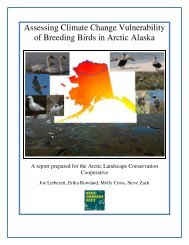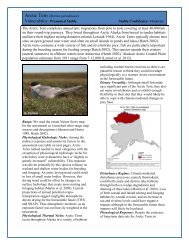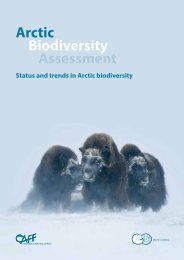Permafrost Terrain Stability and Thermokarst Monitoring: - Arctic LCC
Permafrost Terrain Stability and Thermokarst Monitoring: - Arctic LCC
Permafrost Terrain Stability and Thermokarst Monitoring: - Arctic LCC
You also want an ePaper? Increase the reach of your titles
YUMPU automatically turns print PDFs into web optimized ePapers that Google loves.
90. Lin, Z., Niu, F., Xu, Z., Xu, J., <strong>and</strong> Wang, P., 2010, Thermal regime of a thermokarst<br />
lake <strong>and</strong> its influence on permafrost, Beiluhe Basin, Qinghai-Tibet Plateau. <strong>Permafrost</strong><br />
<strong>and</strong> Periglacial Processes, p. 21, no. 4, p. 315–324.<br />
This paper examined the spatial distribution of permafrost under <strong>and</strong> around a thermokarst<br />
lake, <strong>and</strong> monitored lakeshore retrogression. Eighty percent of the shoreline collapsed each<br />
year, with most of the collapse occurring in the late summer. Thaw depths were greater on<br />
the lakeshore relative to the surrounding terrain, <strong>and</strong> there appeared to be a through-going<br />
talik in the lake bottom. The lake bottom temperature ranged from 2 to 10°C, <strong>and</strong> the warm<br />
lake created a large thaw bulb <strong>and</strong> thermal signature that could be detected in the subpermafrost<br />
ground many tens of meters from the lake edge.<br />
91. Ling, F., <strong>and</strong> Zhang, T., 2004, Modeling study of talik freeze-up <strong>and</strong> permafrost<br />
response under drained thaw lakes on the Alaskan <strong>Arctic</strong> Coastal Plain: Journal of<br />
Geophysical Research, v. 109, no. D1, D01111.<br />
This paper presents a heat transport model to calculate the time needed for the talik beneath<br />
a lake to refreeze following lake drainage. Three initial ground temperature conditions were<br />
considered, <strong>and</strong> taliks of 28, 43, <strong>and</strong> 53 m thickness were determined to refreeze in 40, 106,<br />
<strong>and</strong> 157 years, respectively. Refreezing is slowed significantly by the latent heat of fusion<br />
needed to change water from a liquid to solid form. The authors recognized that a model<br />
also capable of h<strong>and</strong>ling advective heat transport owing to the flow of water in the talik<br />
would result in a more accurate result.<br />
92. Ling, F., Wu, Q., Zhang, T., <strong>and</strong> Niu, F., 2012, Modelling open talik formation <strong>and</strong><br />
permafrost lateral thaw under a thermokarst lake, Beiluhe Basin, Qinghai Tibet<br />
Plateau: <strong>Permafrost</strong> <strong>and</strong> Periglacial Processes, v. 23, no. 4, p. 312–321.<br />
This paper uses a two-dimensional unsteady finite-element model with heat transfer <strong>and</strong><br />
phase change to model talik formation in a study lake. <strong>Thermokarst</strong> lakes constitute a major<br />
heat source capable of raising ground temperatures in the surrounding terrain, <strong>and</strong> the<br />
greatest mean thaw rate (24.8 cm/y) occurred within the first 50 years after lake formation,<br />
93. Little, J.D., S<strong>and</strong>all, H., Walegur, M.T., <strong>and</strong> Nelson, F.E., 2003, Application of<br />
differential global positioning systems to monitor frost heave <strong>and</strong> thaw settlement in<br />
tundra environments: <strong>Permafrost</strong> <strong>and</strong> Periglacial Processes, v. 14, no. 4, p. 349–357.<br />
This paper describes the use of differential Global Positioning Systems (DGPS) for<br />
monitoring seasonal <strong>and</strong> annual frost heave <strong>and</strong> thaw settlement on the <strong>Arctic</strong> Coastal Plain<br />
of northern Alaska. The authors developed acrylite (durable lightweight plastic), tubeshaped<br />
platform targets with a prong-like bottom. The targets were about 20 cm long <strong>and</strong> 2.5<br />
cm in diameter. The targets were installed towards the end of the thaw season. The time<br />
required to make measurements at the targets varied from less than 1minute for stop-<strong>and</strong>-go<br />
kinematic to more than 10 minutes for rapid static DGPS survey mode. Using the rapid<br />
static configuration, the authors surveyed a field site composed of 30 targets using the rapid<br />
static survey method in 5–8 hours with a vertical error of about 1.5 cm. When these surveys<br />
were repeated within <strong>and</strong> among years, the authors measured about 1–2 cm of heave<br />
associated with the freeze-up period <strong>and</strong> 4–5 cm of subsidence at the time of maximum<br />
summer thaw. The advantages of DGPS include great accuracy <strong>and</strong> automatic placement of<br />
surveys within well-established geodetic coordinate systems. Drawbacks involve high costs,<br />
target reinsertion difficulties, <strong>and</strong> physical dem<strong>and</strong>s. DGPS entails significant time<br />
requirements compared to traditional leveling techniques when surveying small areas.<br />
However, DGPS has the potential to measure large regions much more rapidly than classical<br />
methods.<br />
34








